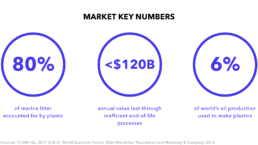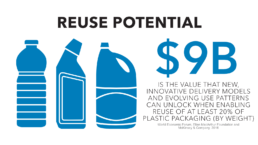Plastics are an integral part of the global economy, but the current linear value chain results in high proportions of underutilised resources that end up in the oceans and threaten marine ecosystems. Innovation opportunities are emerging in material design and the reprocessing of plastics to unlock latent value and protect the oceans.
Plastics were first developed over 170 years ago, and we have since created a wide range of synthetic polymers that are now integrated into almost every part of our lives. They possess unparalleled design versatility and have resulted in many environmental and societal benefits – everything from food packaging extending shelf-life to lightweight vehicle components that reduce transportation fuel consumption. However, the multi-billion dollar plastics industry also creates significant costs inherently linked to the polymer properties. The design versatility and low production costs prohibit easy recycling and typically create short life cycles. Thirty percent of all plastics are estimated not to be reused or recycled, and more than eight million tonnes of plastics end up in the oceans annually – equal to dumping a garbage truck of plastic every minute.

Market Size and Demand Drivers
Over the past 50 years, annual plastic production has increased from 15 million tonnes in 1964 to 311 million tonnes in 2014. Worldwide, the plastics market is expected to reach $650 billion by 2020, and global production is predicted to double in the next 20 years.
The drivers for a different plastic economy include technological breakthroughs, increasing clean energy availability, increasing environmental costs from plastic waste, and a changing regulatory landscape. The UK, France, and Costa Rica are all implementing policies to cut selected single-use plastics by 2021, creating opportunities for more sustainable alternative materials to single-use plastics.

Products and Services
Plastics can be made from anything containing carbon and hydrogen. Fossil fuels have been the primary choice of feedstock until now, but that could change. Econic, for example, uses up to 50% waste CO2 as feedstock to produce new plastics.
Transforming the single-use plastic culture also offers opportunities in product design. Reusable coffee cups and beeswax wrapping can replace single-use, hard-to-recycle coffee cups and plastic wrapping.
Then there is the opportunity for industry to rethink how plastic is made and innovate towards more sustainable products. Lego, a company based entirely on plastic, is on a mission to completely change the plastic it produces by 2030.
Finally, the end-of-life processes for plastics offers the potential for innovation. Improved collection, sorting, and recycling technologies can increase the value extracted from existing plastics.
This market featured in the 2018 Global Opportunity Report.

